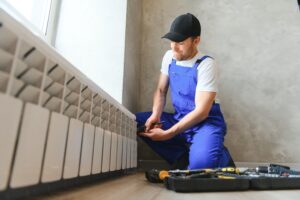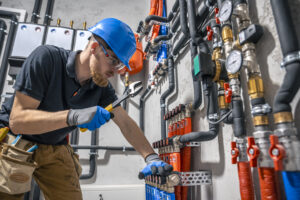Your HVAC system works hard all year long, but the transition between seasons puts extra stress on your equipment. Spring brings the shift from heating to cooling, while fall requires your system to reverse course entirely. Without proper preparation, these seasonal changes can lead to unexpected breakdowns, higher energy bills, and uncomfortable living conditions.
Most homeowners wait until their system fails to take action. This reactive approach often results in emergency repair calls during peak seasons when HVAC technicians are busiest and most expensive. A proactive maintenance routine, however, can prevent 95% of common HVAC problems and extend your system’s lifespan by up to 40%.
This comprehensive checklist will guide you through essential maintenance tasks for both spring and fall transitions. You’ll learn which tasks you can handle yourself and when it’s time to call in professionals. By following these seasonal routines, you’ll ensure your HVAC system operates efficiently year-round while avoiding costly repairs.
Spring HVAC Checklist: Preparing for Cooling Season
Spring marks the beginning of your air conditioning system’s heaviest workload. After months of dormancy, your cooling equipment needs attention before the first hot day arrives.
A/C Inspection and Maintenance
Start your spring preparation with a thorough visual inspection of your air conditioning system. Look for obvious signs of damage like dented condenser coils, loose electrical connections, or refrigerant leaks around the outdoor unit. Check that your system’s electrical disconnect switch is in the “on” position and that the circuit breaker hasn’t tripped.
Examine the condensate drain line for clogs or standing water. A blocked drain can cause water damage and create perfect conditions for mold growth. Pour a cup of white vinegar down the drain line to clear minor blockages and eliminate bacteria buildup.
Test your system by setting the thermostat to cooling mode and lowering the temperature by a few degrees. Listen for unusual noises like grinding, squealing, or banging sounds. Your system should start smoothly and begin producing cool air within 10-15 minutes.
Checking and Replacing Air Filters
Air filters are your HVAC system’s first line of defense against dust, pollen, and other airborne particles. During spring, increased pollen counts and open windows can quickly clog filters that weren’t changed over winter.
Remove your current filter and hold it up to a light source. If you can’t see light passing through clearly, it’s time for a replacement. Even if the filter looks relatively clean, consider changing it if it’s been in place for more than three months.
Choose the right filter for your system and needs. Standard fiberglass filters cost less but only capture large particles. Pleated filters offer better filtration for allergens and dust. High-efficiency particulate air (HEPA) filters provide maximum filtration but may restrict airflow in some systems.
Install the new filter with the airflow arrow pointing toward the blower motor. Mark your calendar to check the filter again in 30 days, as spring allergens can reduce filter life significantly.
Testing Thermostats
Your thermostat controls your entire HVAC system, making it critical for efficient operation. Spring is an ideal time to test all thermostat functions and update settings for the cooling season.
Check that your thermostat is level and securely mounted. Loose thermostats can cause temperature reading errors. Test both heating and cooling modes to ensure smooth transitions between systems. If you have a programmable thermostat, review and update your schedule for longer daylight hours and changing routines.
Consider upgrading to a smart thermostat if your current unit is more than 10 years old. Modern thermostats can reduce energy consumption by up to 23% through advanced scheduling and remote monitoring capabilities.
Replace thermostat batteries if your unit uses them. Even hardwired thermostats often have backup batteries that should be changed annually.
Cleaning Outdoor Units
Your outdoor condenser unit needs unrestricted airflow to operate efficiently. Winter debris like leaves, twigs, and dirt can significantly reduce performance and increase energy costs.
Turn off power to the unit at both the outdoor disconnect switch and the circuit breaker. Remove any visible debris from around the unit, including weeds and vegetation that may have grown too close during winter.
Use a garden hose to gently rinse the condenser coils from inside the unit, working from top to bottom. Avoid using high pressure, which can damage the delicate fins. For stubborn dirt buildup, use a soft brush or specialized coil cleaning solution.
Straighten any bent condenser fins using a fin comb or butter knife. These fins are crucial for heat transfer, and even minor damage can reduce efficiency. Check that the unit sits level on its pad and hasn’t shifted during winter freeze-thaw cycles.
Fall HVAC Checklist: Preparing for Heating Season
Fall preparation focuses on your heating system and ensuring your home is ready for months of continuous operation. This season’s maintenance prevents mid-winter breakdowns when you need heat most.
Furnace Inspection and Maintenance
Begin with a visual inspection of your furnace area. Clear any stored items that may have accumulated over summer, maintaining at least three feet of clearance around the unit. Check that the furnace door is properly secured and that access panels haven’t become loose.
Inspect the heat exchanger for cracks or corrosion. While homeowners can look for obvious damage, heat exchanger problems often require professional detection equipment. Signs of heat exchanger issues include rust flakes near the unit, soot buildup, or a yellow burner flame instead of blue.
Test your furnace by setting the thermostat to heating mode and raising the temperature setting. The system should ignite smoothly and begin producing warm air. Listen for unusual noises during startup and operation.
Check the furnace filter, which may need more frequent changes during heating season due to increased runtime. A dirty filter forces your furnace to work harder, reducing efficiency and potentially causing overheating.
Checking and Sealing Ductwork
Ductwork problems can waste up to 30% of your heating energy and create uneven temperatures throughout your home. Fall is the perfect time to inspect accessible ducts and seal obvious leaks.
Examine visible ductwork in basements, crawl spaces, and attics for disconnected joints, holes, or damaged insulation. Feel around duct connections for air leaks while your system is running. Use duct tape or mastic sealant to close small gaps, but remember that significant ductwork repairs require professional attention.
Check that all supply and return vents are open and unobstructed. Furniture, curtains, and other items can block airflow and create pressure imbalances. Vacuum dust buildup from vent covers and consider professional duct cleaning if you notice excessive dust or odors.
Inspect ductwork insulation in unconditioned spaces. Damaged or missing insulation allows heated air to escape and can cause condensation problems during cold weather.
Inspecting Ventilation Systems
Proper ventilation prevents moisture buildup and maintains healthy indoor air quality during months of closed windows. Check all exhaust fans in bathrooms, kitchens, and laundry areas for proper operation.
Test exhaust fans by turning them on and holding a tissue near the intake. The tissue should be drawn toward the fan, indicating adequate suction. Clean dust buildup from fan grilles and consider professional cleaning for fans that haven’t been serviced in several years.
Inspect attic ventilation to ensure proper airflow. Blocked soffit vents or ridge vents can cause ice dams and reduce energy efficiency. Remove any debris and check that insulation hasn’t covered ventilation openings.
Verify that bathroom and kitchen exhaust fans vent to the outside, not into attic spaces where moisture can cause mold and structural damage.
Ensuring Carbon Monoxide Detectors are Functional
Carbon monoxide poisoning risk increases during heating season due to greater combustion appliance use and reduced ventilation. Test all carbon monoxide detectors and replace batteries if needed.
Install carbon monoxide detectors on every level of your home, especially near bedrooms and combustion appliances. Units should be replaced every 5-7 years, even if they appear to be working properly.
Know the symptoms of carbon monoxide poisoning: headaches, dizziness, nausea, and fatigue. If your detector alarms, evacuate immediately and call emergency services.
Consider upgrading to connected carbon monoxide detectors that can alert you remotely and provide voice announcements about the specific danger detected.
Professional Services: When to Call New Jersey HVAC
While homeowners can handle many maintenance tasks, some situations require professional expertise. Attempting complex repairs without proper training can be dangerous and may void equipment warranties.
When to Call a Professional
Contact a professional HVAC technician if you notice refrigerant leaks, electrical problems, or unusual noises that persist after basic maintenance. Gas furnace issues, including pilot light problems or suspected heat exchanger damage, always require professional attention.
Schedule professional maintenance if your system is more than 10 years old or if you haven’t had professional service in the past two years. Annual professional maintenance can identify problems before they become expensive repairs.
Call for professional help if your energy bills increase significantly without explanation, if some rooms remain uncomfortable despite system operation, or if you notice frequent cycling on and off.
Emergency situations like complete system failure, gas odors, or carbon monoxide detector activation require immediate professional response.
Overview of Services Offered by New Jersey HVAC
New Jersey HVAC provides comprehensive services for residential and commercial properties throughout the state. Our central air installation services include complete system design, proper sizing calculations, and expert installation that maximizes efficiency and comfort.
We specialize in condenser and air handler replacement, ensuring proper matching between components for optimal performance. Our thermostat installation and programming services help homeowners maximize comfort while minimizing energy costs.
For heating systems, we offer complete furnace replacement services, from efficiency analysis to final installation and testing. Our freon filling services restore proper refrigerant levels, while our leak detection capabilities identify and repair system leaks before they cause expensive damage.
Our humidifier installation and maintenance services improve indoor air quality and comfort during dry winter months. We also provide comprehensive ductwork services, including design, installation, and cleaning for optimal system performance.
New Jersey HVAC’s engineering and system design services ensure that every installation meets your specific needs and local building codes. We work on projects ranging from single-family homes to large industrial warehouses, bringing the same attention to detail and expertise to every job.
Our boiler service and installation capabilities cover both residential and commercial applications. We also offer comprehensive energy solutions, including efficiency audits and recommendations for reducing operating costs.
What sets New Jersey HVAC apart is our commitment to being accurate, responsive, and easy to work with. We understand that HVAC problems can’t wait, which is why we provide reliable service when you need it most.
Take Action Before You Need It
Regular HVAC maintenance isn’t just about preventing breakdowns—it’s about protecting your investment and ensuring year-round comfort. The checklists provided here give you a foundation for maintaining your system, but remember that professional service remains essential for complex issues and annual tune-ups.
Start implementing these seasonal routines now, before your system shows signs of problems.






